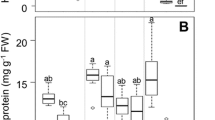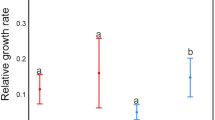Abstract
Although little is known about the patterns of chemical defense allocation in reproductive tissues, optimal defense theory predicts a high constitutive allocation due to the tissues' high fitness value. To examine this prediction, we quantified the short- and long-term changes in the nicotine pools of reproductive tissues in response to both floral and leaf damage. Recently opened flowers (stage 5 capsules) do not alter their nicotine pools within a day in response to herbivory byManduca sexta larvae or mechanical damage to the corolla. Similarly, leaf damage during both vegetative and reproductive growth does not influence the nicotine pools of the first three stage-5 capsules produced. However, the nicotine pools of capsules produced later in reproductive growth were significantly larger (1.2- to 1.9-fold) on plants with leaf damage. These differences in floral nicotine pools were a result of both increases in nicotine pools of capsules on damaged plants and decreases in the nicotine pools of capsules on undamaged plants during reproductive growth. Leaf damage did not affect the rate of capsule maturation or the mass of stage-5 capsules at any time during reproductive growth. An allometric analysis of nicotine pools and biomass of reproductive parts in all stages of development from damaged and undamaged plants demonstrates that damaged plants allocated a significantly larger quantity of nicotine to reproductive parts in all stages of development than did undamaged plants. Given that nicotine is thought to be synthesized in the roots and transported to leaves and reproductive parts, nicotine could be allocated to reproductive parts in proportion to the number of developing capsules on a plant. We excised the first 27 stage-5 capsules on plants with and without leaf damage, with the expectation that plants with fewer capsules would allocate a larger amount of nicotine to the remaining capsules. In contrast to the prediction of this passive allocation model, floral excision did not affect nicotine pools on plants with or without leaf damage. These results demonstrate that the allocation of nicotine to reproductive parts is more strongly influenced by damage to vegetative rather than reproductive tissues. Reproductive parts are constitutively defended over the short term, but the set points for defense allocation are apparently increased by damage to vegetative tissues during reproductive growth. The decrease in allocation of nicotine to reproductive parts in undamaged plants during reproductive growth suggests an optimization of resource allocation as plants realize their potential fitness.
Similar content being viewed by others
References
Baldwin, I.T. 1988. Damaged-induced alkaloids in tobacco: Pot-bound plants are not inducible.J. Chem. Ecol. 4:1113–1120.
Baldwin, I.T. 1969. Mechanism of damage-induced alkaloid production in wild tobacco.J. Chem. Ecol. 15:1611–1680.
Baldwin, I.T. 1993. Chemical changes rapidly induced by folivory, pp. 1–23,in E.A. Bernays (ed.). Insect-Plant Interactions, Vol. 5. CRC Press, Boca Raton, Florida.
Baldwin, I.T., andOhnmeiss, T.E. 1993. Alkaloidal responses to damage inNicotiana native to North America.J. Chem. Ecol. 19:1143–1153.
Baldwin, I.T., andOhnmeiss, T.E. 1994. Coordination of photosynthetic and alkaloidal responses to leaf damage in uninducible and inducibleNicotiana sylvestris.Ecology 75:1003–1014.
Baldwin, I.T., Karb, M.J., andOhnmeiss, T.E. 1994. Allocation of15N from nitrate to nicotine: Production and turnover of an induced defense,Ecology. 75:1703–1713.
Baldwin, I.T., Stascak-Kozinski, L., andDavidson, R. 1994b. Up in smoke: I. Smoke-derived germination cues for the post fire annualNicotiana attenuata Torr ex Watson.J. Chem. Ecol. 20:2345–2371.
Boodley, J.W., andSheldrake, R.J. 1977. Cornell peat-lite mixes for commercial plant growing. Cornell Information Bulletin 43. Ithaca, New York.
Gershenzon, J., andCroteau, R. 1991. Terpenoids, pp. 165–219,in G.A. Rosenthal and M.R. Berenbaum. Herbivores: Their Interactions with Secondary Plant Metabolites. Academic Press, San Diego.
Goodspeed, T.H. 1954. The GenusNicotiana. Chronica Botanica Co., Waltham, Massachusetts.
Heftmann, E., andSchwimmer, S. 1972. Degradation of tomatine to 3β-hydroxy-5δ-pregn-16-enone by ripe tomatoes.Phytochemistry 11:2783–2787.
Hendrix, S.D., andTrapp, E.J. 1981. Plant-herbivore interactions: Insect-induced changes in host plant sex expression and fecundity.Oecologia 49:119–122.
McKey, D. 1974. Adaptive patterns in alkaloid physiology.Am. Nat. 108:305–320.
McKey, D. 1979. The distribution of secondary compounds within plants, pp. 55–133,in G.A. Rosenthal and D.H. Janzen (eds.). Herbivores: Their Interactions with Secondary Plant Metabolites. Academic Press, New York.
McNamara, K. 1986. A guide to the nonmenclature of heterochrony.J. Paleontol. 60:4–13.
Nitao, J.K. 1988. Artificial defloration and furanocoumarin induction inPastinaca sativa (Umbelliferae).J. Chem. Ecol. 14:1515–1522.
Ohnmeiss, T.E., andBaldwin, I.T. 1994. The allometry of nitrogen allocation to growth and an inducible defense under nitrogen-limited growth.Ecology 75:995–1002.
Pearce, G., Ryan, C.A., andLiljegren, D. 1988. Proteinase inhibitors I and II in fruit of wild tomato species: Transient components to a mechanism for defense and seed dispersal.Planta 175:527–531.
Rhoades, D.F. 1979. Evolution of plant chemical defense against herbivores, pp. 4–54,in G.A. Rosenthal and D.H. Janzen (eds.). Herbivores: Their Interactions with Secondary Plant Metabolites. Academic Press, New York.
Rhoades, D.F. 1983. Herbivore population dynamics and plant chemistry, pp. 155–220,in R.F. Denno and M. McClure (eds.). Variable Plants and Herbivores in Natural and Managed Systems. Academic Press, New York.
Samson, D.A., andWerk, K.S. 1986. Size-dependent effects in the analysis of reproductive effort in plants.Am. Nat. 127:667–680.
Welter, S.C. 1989. Arthropod impact on plant gas exchange, pp. 135–150,in E.A. Bernays (ed.). Insect-Plant Interactions. CRC Press, Boca Raton, Florida.
Zangerl, A.R. 1986. Leaf value and optimal defense inPastinaca sativa L. (Umbelliferae).Am. Midl. Nat. 116:432–437.
Zangerl, A.R. 1990. Furanocoumarin induction in wild parsnip: Evidence for an induced defense against herbivores.Ecology 71:1926–1932.
Zangerl, A.R., andBazzaz, F.A. 1992. Theory and pattern in plant defense allocation, pp. 363–391,in R.S. Fritz and E.L. Simms (eds.). Plant Resistance to Herbivores and Pathogens: Ecology, Evolution, and Genetics. University of Chicago Press, Chicago.
Author information
Authors and Affiliations
Rights and permissions
About this article
Cite this article
Baldwin, I.T., Karb, M.J. Plasticity in allocation of nicotine to reproductive parts inNicotiana attenuata . J Chem Ecol 21, 897–909 (1995). https://doi.org/10.1007/BF02033797
Received:
Accepted:
Issue Date:
DOI: https://doi.org/10.1007/BF02033797




